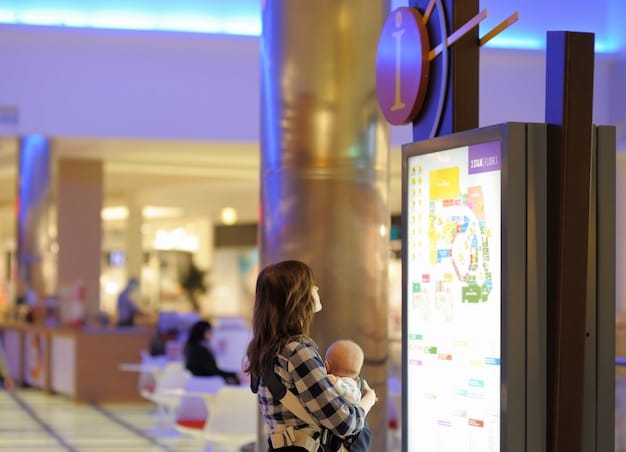The Future of Retail: E-commerce and the In-Store Experience

The Future of Retail: E-commerce Trends and the In-Store Experience explores the dynamic interplay between online and physical shopping, highlighting how retailers are innovating to meet evolving consumer expectations through personalized experiences, seamless omnichannel strategies, and technological integrations.
The retail landscape is undergoing a dramatic transformation, driven by the rise of e-commerce and the evolving expectations of consumers. Understanding the Future of Retail: E-commerce Trends and the In-Store Experience is crucial for businesses looking to thrive in this dynamic environment.
E-commerce Dominance and Its Impact on Retail
E-commerce has reshaped the retail industry, offering convenience and a vast selection to consumers. This section explores the extent of e-commerce dominance and its ripple effects on traditional brick-and-mortar stores.
The rise of online shopping has forced retailers to rethink their strategies. Understanding these shifts is essential for staying competitive.
The Growth of Online Sales
Online sales have consistently grown year over year, capturing a significant portion of the retail market. This growth has been fueled by factors such as increased internet access, mobile shopping, and the convenience of home delivery.
Changing Consumer Behavior
Consumers now expect a seamless shopping experience across all channels. They want to be able to browse products online, read reviews, and compare prices before making a purchase, whether they buy online or in-store.

- Personalization: E-commerce platforms can tailor product recommendations and offers based on individual browsing history and preferences.
- Convenience: Online shopping offers the convenience of shopping from anywhere at any time, without the need to travel to a physical store.
- Price Comparison: Consumers can easily compare prices from different retailers, ensuring they get the best deal.
- Product Variety: E-commerce sites often offer a wider selection of products than traditional stores, including niche and specialty items.
In conclusion, e-commerce dominance has significantly impacted the retail landscape, forcing retailers to adapt to changing consumer behaviors and invest in online channels.
The Resurgence of the In-Store Experience
Despite the growth of e-commerce, the in-store experience is making a comeback. This section explores how retailers are reinventing their physical spaces to attract and engage customers.
Brick-and-mortar stores are no longer just places to buy products; they are becoming destinations for unique and immersive experiences.
Creating Immersive Environments
Retailers are designing stores that offer sensory experiences, such as interactive displays, product demonstrations, and personalized consultations. These immersive environments aim to create emotional connections with customers.
The Role of Technology
Technology is playing a key role in enhancing the in-store experience. From digital kiosks and augmented reality apps to personalized recommendations and mobile checkout, technology is transforming the way people shop in physical stores.
- Personalized Service: In-store staff can provide personalized recommendations and assistance, addressing individual customer needs and preferences.
- Sensory Engagement: Physical stores offer the opportunity to touch, feel, and try products before making a purchase, enhancing the sensory shopping experience.
- Social Interaction: Shopping in a physical store can be a social activity, allowing customers to browse with friends or family and interact with store staff.
- Immediate Gratification: Customers can take their purchases home immediately, without having to wait for shipping.
In conclusion, the in-store experience is being revitalized through immersive environments, technology integration, and a greater focus on customer service.
Omnichannel Strategies: Bridging the Gap
Omnichannel strategies are essential for creating a seamless shopping experience across all channels. This section explores how retailers are integrating their online and offline operations to meet customer expectations.
An effective omnichannel strategy ensures that customers can interact with a retailer in a consistent and convenient manner, regardless of the channel they choose.
Click-and-Collect Services
Click-and-collect, also known as buy online, pick up in-store (BOPIS), allows customers to purchase products online and pick them up at a physical store. This service offers convenience and saves on shipping costs.
Seamless Returns and Exchanges
Retailers are making it easier for customers to return or exchange products, regardless of whether they were purchased online or in-store. This flexibility enhances customer satisfaction and loyalty.

- Consistent Branding: Maintaining a consistent brand identity across all channels helps to reinforce brand recognition and build trust with customers.
- Integrated Inventory Management: Real-time inventory visibility ensures that customers can see product availability regardless of whether they are shopping online or in-store.
- Personalized Communication: Tailoring marketing messages and offers based on individual customer preferences and behaviors enhances engagement and drives sales.
- Mobile Integration: Mobile apps and websites provide customers with on-the-go access to product information, promotions, and store locations.
In conclusion, omnichannel strategies are crucial for bridging the gap between online and offline shopping, creating a seamless and convenient customer experience.
Personalization: Tailoring the Retail Experience
Personalization is becoming increasingly important in retail, as consumers expect brands to understand their individual needs and preferences. This section explores how retailers are using data and technology to tailor the shopping experience.
By leveraging customer data, retailers can create personalized experiences that drive engagement, loyalty, and sales.
Data-Driven Insights
Retailers are collecting data from various sources, including online browsing history, purchase data, and social media activity, to gain insights into customer behaviors and preferences. This data is then used to personalize product recommendations, offers, and marketing messages.
AI-Powered Personalization
Artificial intelligence (AI) is playing a key role in personalization, enabling retailers to deliver customized experiences at scale. AI algorithms can analyze vast amounts of data to identify patterns and predict customer behavior, allowing retailers to proactively address individual needs.
Personalization enhances customer experience, increases revenue.
- Personalized Product Recommendations: Suggesting products based on past purchases, browsing history, and preferences.
- Customized Offers and Promotions: Tailoring offers and promotions to individual customer needs and interests.
- Personalized Content: Delivering content, such as blog posts and videos, that is relevant to individual customer preferences.
- Personalized Customer Service: Providing personalized support and assistance based on individual customer needs and issues.
In conclusion, personalization is transforming the retail experience, enabling retailers to deliver tailored experiences that drive engagement and loyalty.
The Role of Mobile Technology in Retail
Mobile technology has become an integral part of the retail experience, empowering consumers with information and convenience. This section explores how retailers are leveraging mobile devices to enhance the shopping journey.
Mobile devices are transforming the way people shop, providing access to product information, promotions, and online stores anytime, anywhere.
Mobile Shopping Apps
Retailers are developing mobile apps that allow customers to browse products, make purchases, manage rewards programs, and receive personalized offers. These apps provide a convenient and engaging shopping experience.
Mobile Payments
Mobile payment systems, such as Apple Pay and Google Pay, are making it easier for customers to make purchases in-store and online. These systems offer a secure and convenient way to pay, without the need for cash or credit cards.
Improved convenience with mobile devices.
- Mobile Product Scanners: Allowing customers to scan product barcodes to access product information, reviews, and pricing.
- Mobile Checkout: Enabling customers to check out and pay for purchases using their mobile devices, without having to wait in line.
- Location-Based Services: Providing customers with location-based offers and promotions when they are near a physical store.
- Augmented Reality (AR) Shopping: Using AR technology to allow customers to virtually try on clothes or visualize furniture in their homes before making a purchase.
In conclusion, mobile technology is playing a key role in transforming the retail experience, providing consumers with increased convenience, information, and personalized offers.
Sustainability and Ethical Considerations
Sustainability and ethical considerations are becoming increasingly important to consumers, who are demanding more transparency and accountability from retailers. This section explores how retailers are addressing these concerns.
Consumers are increasingly concerned about the environmental and social impact of their purchases, and they are choosing to support brands that align with their values.
Sustainable Sourcing
Retailers are focusing on sourcing products from sustainable and ethically responsible suppliers. This includes using eco-friendly materials, reducing waste, and ensuring fair labor practices.
Transparency and Traceability
Consumers want to know where their products come from and how they are made. Retailers are providing more information about their supply chains, allowing customers to make informed purchasing decisions.
Sustainability drives customer loyalty.
- Eco-Friendly Packaging: Using recyclable and biodegradable packaging materials to reduce waste.
- Reducing Carbon Footprint: Implementing measures to reduce carbon emissions throughout the supply chain.
- Supporting Fair Trade Practices: Partnering with suppliers who adhere to fair trade principles, ensuring fair wages and working conditions for farmers and workers.
- Promoting Circular Economy: Encouraging customers to recycle or return used products for reuse or repurposing.
In conclusion, sustainability and ethical considerations are becoming integral to the retail industry, as retailers respond to growing consumer demand for responsible business practices.
| Key Point | Brief Description |
|---|---|
| 📈 E-commerce Growth | Online sales continue to rise, impacting traditional retail. |
| 🛍️ In-Store Revival | Physical stores are enhancing experiences to attract customers. |
| 📱 Mobile Integration | Mobile technology enhances shopping convenience and access. |
| 🌱 Sustainability | Consumers prioritize sustainable and ethical retail practices. |
FAQ
▼
E-commerce is expanding consumer choice and increasing convenience. Retailers must respond with strong online presences and competitive pricing.
▼
In-store experiences allow customers to physically interact with products. This builds trust in the brand and purchase satisfaction.
▼
An omnichannel strategy integrates all sales channels into a unified system. This provides the customer with a seamless shopping experience.
▼
Personalization uses customer data for targeted marketing. Enhances relevance and thus purchase probability with customized offers.
▼
Customers favor sustainable brands. Sustainable practices drive loyalty and positive brand image. These also help protect the environment.
Conclusion
The future of retail hinges on the symbiotic relationship between e-commerce innovations and enhanced in-store experiences. Retailers that successfully blend these elements, prioritizing personalization, seamless omnichannel strategies, and a commitment to sustainability, will be best positioned to thrive in the evolving market.





